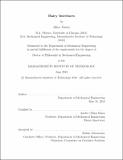Hairy interfaces
Author(s)
Nasto, Alice M. (Alice Meite)
DownloadFull printable version (18.04Mb)
Other Contributors
Massachusetts Institute of Technology. Department of Mechanical Engineering.
Advisor
Anette (Peko) Hosoi.
Terms of use
Metadata
Show full item recordAbstract
Textured surfaces are known to play an important role in water-repellency and uptake for a number of creatures. While the influence of chemistry and surface roughness on the wettability of surfaces has been studied extensively, little is known about the role of larger-scale objects such as hairs. This thesis is directed towards rationalizing the benefits gained from hairy textures through a combined experimental and theoretical approach. First, we are motivated by semi-aquatic mammals, who rely on fur for insulation underwater. This thesis investigates the mechanism of dynamic air entrainment for hairy surfaces plunged in liquid. Hairy surfaces that are fabricated by casting PDMS elastomer in laser cut molds are plunged into a fluid bath. Modeling the hairy texture as a network of capillary tubes, the imbibition speed of liquid into the hairs is obtained through a balance of hydrostatic pressure and viscous stress. In this scenario, the bending of the hairs, capillary forces, and inertial effects are negligible. The maximum diving depth that can be achieved before the hairs are wetted to the roots is predicted from a comparison of the diving speed and imbibition speed. Second, motivated by nectar-drinking animals with hairy tongues, we investigate the reverse scenario, where a hairy surface is withdrawn from a bath of fluid, emerging with viscous liquid entrained in the hairy texture. The drainage of the liquid trapped between the texture is modeled using a Darcy-Brinkmann like approach. The amount of fluid that is entrained depends on the viscosity of the fluid, the density of the hairs, and the withdrawal speed. Both theory and experiments show that there is an optimal hair density to maximize fluid uptake. Finally, we investigate drop impact on hairy surfaces. By varying the speed of the drop, the spacing of the hairs, and the viscosity of the liquid, we observe a variety of behaviors. In some cases, the liquid drop can remain on top of the hair after impact, similar to a Cassie-Baxter state. If the drop penetrates the hairy surface, the hairs can resist its spreading. Using this scenario as a reference case, we rationalize the role of the hairs in mitigating the inertia of the impacting drop through a balance of inertial, viscous, and surface tension effects.
Description
Thesis: Ph. D., Massachusetts Institute of Technology, Department of Mechanical Engineering, 2018. This electronic version was submitted by the student author. The certified thesis is available in the Institute Archives and Special Collections. Cataloged from student-submitted PDF version of thesis. Includes bibliographical references (pages 97-102).
Date issued
2018Department
Massachusetts Institute of Technology. Department of Mechanical EngineeringPublisher
Massachusetts Institute of Technology
Keywords
Mechanical Engineering.